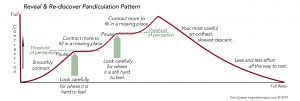Look inward to find what you lost
“Direct the searchlight of your awareness inward.”
-Thomas Hanna, PhD. Developer of Somatics
Look inward to change the threshold of your perception.
Look inward to fill in the missing places of the map your brain has of your body.
Look inward to teach your system to recalibrate so you can sense, at lower tension, the previously un-sensable, forgotten places. This is how to regain control of your musculature.
The sensing of your anatomy is incomplete, distorted, and fragmented because of how your system normalizes persistent tensions. The places that are persistently held become difficult to sense. Your system forgets that the tightly held places are even there. Your system is running your muscles at a level below the threshold of your awareness. You don’t even know it’s happening. Your brain controls the muscle tension based on what it perceives. This tension causes pain, stiffness, and postural distortion and effects mood.
Your nervous system is set up to sense and move, using your sensory-motor cortex, the cerebellum, and both sensory and motor neurons. As you move, there is a constant interplay, a feedback loop of moving and sensing, moving and sensing. The sensory feedback allows you to control your movement.
The pandiculations of the Somatics process allow you to reset your system. The focused process of looking inward is essential if you desire an experience of freedom, and to feel more whole in your embodiment.
In your Somatics practice, the sensory-motor feedback system is the pathway you use to teach your nervous system that you are in control of your musculature. The auto-pilot has been running things long enough. Give it a good schooling! Masterfully bring the automatic patterns under your voluntary control.
Try this in your Somatic Movement practice:
- Close your eyes and look inward.
- Contract softly into the movement.
- Move partially into the contraction to develop the feedback sensation with discernment.
- Pause.
- Concentrate your awareness on the sensation you create.
- Focus your awareness to look very carefully for here it is hard to sense? Is there a gap in the sensation?
- Contract that hard-to-feel place a little more, to fill in the gap with sensation.
- Use enough effort to hear how that place sings its feedback song.
- Open so slowly that the sensing and moving area of your brain (the sensory-motor cortex) can successfully process the entire movement, as you ease smoothly in the descent back to complete rest.
- Be present. In real time, control the movement all the way to the end, to complete relaxation.

Can you look inward to complete the map? Can you look inward to recalibrate your brain’s perception of muscle tension? Can you look inward to bring what was outside of your awareness, into your awareness?
Look inward to free yourself from the involuntary, hard-to-sense patterns of stress response, and the other patterns your brain has learned to hold you in. How you do the movement, how you focus your awareness in the movement, yields the discoveries that help you build greater self-knowing, making you whole.
Practicing often is the way to make deep changes, to feel at ease, and to help your body heal. A careful, patient and inward looking practice allows you to bring a greater durability to the positive changes.
Your Somatics exploration is a powerful sensory feedback practice. Perceptive inward-looking movement fills in the map your brain has of your body, and allows you to create a more complete somatic self-knowing. When you develop a deeper connection to your sensory-motor system, you will feel more balanced, graceful, and ready to flow through life.
-Eric Cooper
inspiresomatics.com
11.24.2019